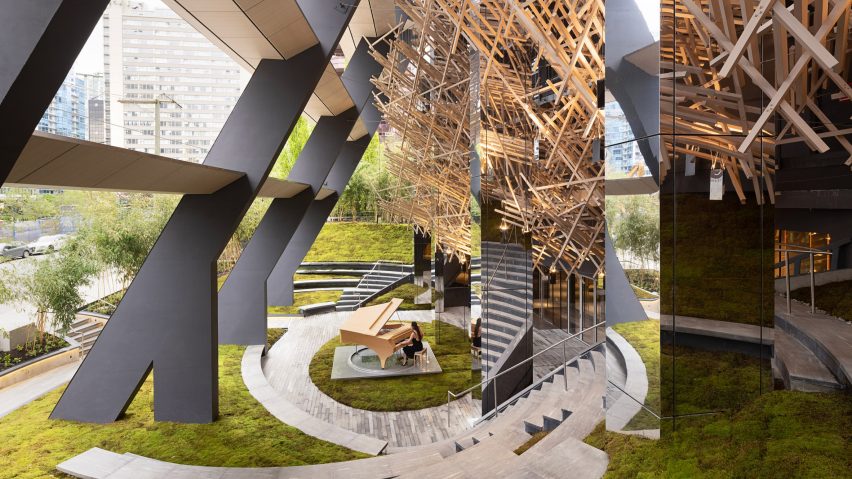Japanese architecture studio Kengo Kuma & Associates has completed a skyscraper in Vancouver, Canada, with a curved form and a semi-enclosed amphitheatre at its base.
Called Alberni by Kengo Kuma, the 43-storey residential skyscraper by Kengo Kuma & Associates (KKAA) is located in downtown Vancouver, near the waterfront in the Coal Harbour neighbourhood.
Its curved structure has a massing that arches away from the street as it rises and straightens out near the top.
The studio described this form as "Boolean scoops", which were included to both preserve the views of the existing buildings on the block and to bring light to the apartments deeper in the skyscraper.
The curve also allows for each apartment in the building to have a recessed balcony and for air to flow through the building.
"The result is sculptural and iconic, distinct on the skyline, but also arising from neighborly and experiential reasons," studio founder Kengo Kuma told Dezeen.
The sides and top of the structure are clad in glass and aluminium panels, while the apartments within the "scoop" have long balconies with wooden details.
The panels are layered in different ways across the facade, creating a textured visual pattern reminiscent of patchwork.
According to KKAA, the skyscraper was designed to respond to the skyline of Vancouver, which is known for its dense cluster of glass-clad skyscrapers.
"The uniformity of Vancouver's skyscraper materiality is both its strength – a characteristic, unified cityscape – and its opportunity to provide something different," said Kuma.
"Our decisions were less a direct reaction to the ubiquitous glass and more an intent to create a tower whose tall mass was made of smaller pieces, keeping to the realm of metal and wood," he continued.
"The tower does not deploy glass as a mass-defining material, and more of a practical enclosure – that is, for the design, the glass is conceptually 'not there'".
The structural beams that run up the facade extend over the entrance massing and connect with the ground, creating an enclosed space where an amphitheatre and moss garden have been created.
The fins that define the long balconies along the "scoop" continue down and work to further shield the semi-enclosed area.
Within the amphitheatre is a Fazioli piano designed by Kuma, a collaborative element included in all the projects carried out by local developer, Westbank, which led the Alberni project.
According to Kuma, the semi-enclosed space was meant to function as an entry lobby for the building. A series of mirror-clad columns transect the open-air space.
"Instead of enclosure, the entrance is a cloud of thin, light elements floating over a performance space," said Kuma.
"Activity and ephemeral elements welcome the city and the building's residents, a very different and much bigger gesture than a small, fortress-like vestibule."
Above the amphitheatre and in the interior pool area is a suspended sculpture meant to resemble a kigumi, a work of Japanese wood joinery. Because of fire restrictions, the sculpture was made out of aluminium treated to look like wood.
KKAA partner in charge Balazs Bognar said that the studio originally wanted to use wood and that the "heartache of giving up this material aspect was a challenge".
The interiors of the public spaces are minimal, with stone and wood details that reference the exterior of the tower. Amenities include the aforementioned swimming pool and a music room with a selection of records and speakers built into the cork-lined walls. A Japanese restaurant will also be opened in the tower.
Kuma said that the structure is in-line with much of his previous work that demonstrates how large buildings can be made from a series of "smaller pieces".
"Our interest is in the relationships to the surroundings rather than solely in the things themselves, and multiple smaller pieces suggests a more porous relationship, as opposed to heavier, solid volumes, to the site via views, air, light," he said.
"For us, a building is not a self-contained object but a series of relationships enabled by architectural actions, he continued. "Some see a building; we see connections and activities."
Other recent projects by Kuma, who founded his studio in 1990, include the Japan National Stadium, created for the 2020 Tokyo Olympic Games. Currently, the studio is working with the developer on a plant-covered building in California's Silicon Valley that will feature a "green lung".
Westbank has developed a number of other buildings in Vancouver, including Danish architecture studio BIG's Vancouver House, a 52-storey skyscraper that twists up from a triangular base.
The photography is by Ema Peter.

